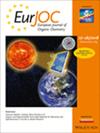3,3‐二氟脱氨唾液酸(C3DFKDN)的合成
IF 2.5
3区 化学
Q2 CHEMISTRY, ORGANIC
引用次数: 0
摘要
2‐酮‐3‐脱氧‐d‐甘油‐d‐半乳糖非醛酸(KDN)是唾液酸家族的九碳单糖。作为N -乙酰神经氨酸(Neu5Ac)的脱胺类似物,KDN在C5上具有羟基而不是胺。虽然KDN在哺乳动物组织中含量较低,但在某些肿瘤细胞和病原体中含量丰富,这使得它及其加工酶成为了解生物功能和开发潜在治疗方法的重要靶点。氟化碳水化合物衍生物被广泛用于探测和调节碳水化合物活性酶(CAZymes)。在这里,我们报道了3,3 -二氟KDN (C3DFKDN)的首次全合成,这是一种新型的氟化唾液酸衍生物,也是设计针对KDN加工酶的共价抑制剂和基于活性的探针的关键中间体。引入C3 -二氟基团可防止消除与单氟唾液酸类似物常见的副反应。研究人员探索了两种合成策略:(1)将吡喃糖前体与二氟化溴化炔偶联,然后氧化;(2)通过Reformatsky型反应加入二氟乙酸基。后一种方法被证明是更有效的,从甲基α‐d‐甘露吡喃苷中获得保护的C3DFKDN,在12步内总收率为3.7%。这项工作建立了C3 -二氟化唾液酸的合成方法,并为开发KDN相关酶途径的氟化探针和抑制剂提供了基础。本文章由计算机程序翻译,如有差异,请以英文原文为准。
Towards the Synthesis of 3,3‐Difluoro Deaminated Sialic Acid (C3DFKDN)
2‐Keto‐3‐deoxy‐d‐glycero‐d‐galacto‐nononic acid (KDN) is a nine‐carbon monosaccharide of the sialic acid family. As a deaminated analogue of N‐acetylneuraminic acid (Neu5Ac), KDN features a hydroxyl group at C5 instead of an amine. Although present at low levels in mammalian tissues, KDN is abundant in certain tumor cells and pathogens, making it and its processing enzymes attractive targets for understanding biological functions and developing potential therapeutics. Fluorinated carbohydrate derivatives are widely used to probe and modulate carbohydrate‐active enzymes (CAZymes). Here, we report the first total synthesis of 3,3‐difluoro KDN (C3DFKDN), a novel fluorinated sialic acid derivative and a key intermediate for designing covalent inhibitors and activity‐based probes targeting KDN‐processing enzymes. Introduction of a C3‐difluoro group prevents elimination side reactions common with monofluorinated sialic acid analogues. Two synthetic strategies were explored: (1) coupling a pyranose precursor with a difluorinated alkyne bromide followed by oxidation, and (2) incorporation of a difluoroacetate building block via a Reformatsky‐type reaction. The latter approach proved more effective, affording protected C3DFKDN in an overall yield of 3.7% over 12 steps from methyl α‐d‐mannopyranoside. This work establishes methodology for the synthesis of C3‐difluorinated sialic acids and provides a foundation for developing fluorinated probes and inhibitors of KDN‐related enzymatic pathways.
求助全文
通过发布文献求助,成功后即可免费获取论文全文。
去求助
来源期刊
CiteScore
5.40
自引率
3.60%
发文量
752
审稿时长
1 months
期刊介绍:
The European Journal of Organic Chemistry (2019 ISI Impact Factor 2.889) publishes Full Papers, Communications, and Minireviews from the entire spectrum of synthetic organic, bioorganic and physical-organic chemistry. It is published on behalf of Chemistry Europe, an association of 16 European chemical societies.
The following journals have been merged to form two leading journals, the European Journal of Organic Chemistry and the European Journal of Inorganic Chemistry:
Liebigs Annalen
Bulletin des Sociétés Chimiques Belges
Bulletin de la Société Chimique de France
Gazzetta Chimica Italiana
Recueil des Travaux Chimiques des Pays-Bas
Anales de Química
Chimika Chronika
Revista Portuguesa de Química
ACH—Models in Chemistry
Polish Journal of Chemistry.

 求助内容:
求助内容: 应助结果提醒方式:
应助结果提醒方式:


